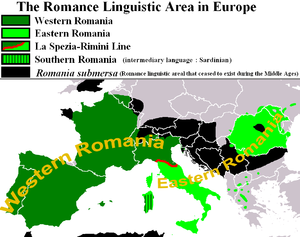| Southern Romance | |
|---|---|
| Geographic distribution | Corsica, Sardinia, Roman Africa |
| Linguistic classification | Indo-European |
| Subdivisions |
|
| Language codes | |
| Glottolog | sout3158 |
 Sardinia as part of the Southern Romance group in Europe | |
The Southern Romance languages are a primary branch of the Romance languages.
According to the classification of linguists such as Leonard (1980) and Agard (1984), the Southern Romance family is composed of Sardinian, Corsican, and the southern Lucanian dialects.[1]
This theory is far from universally supported. In fact, the majority of linguists classify Corsican, including Gallurese and Sassarese as its dialects, as part of Italo-Dalmatian and closely related to Tuscan or the centro-southern Italian dialects,[2][3][4][5][6][7] because of the island's considerable degree of tuscanization during the Middle Ages, leaving Sardinian as the only remaining representative of the branch once the African Romance dialects had gone extinct,[8] unless the southern Lucanian dialects are also classified as part of this branch, as they show some important traits in common with Sardinian.
- ^ Subfamily: Southern Romance, Glottolog
- ^ Guarnerio P.E. (1902). Il sardo e il còrso in una nuova classificazione delle lingue romanze. AGI 16. p. 491-516.
- ^ Tagliavini C. (1972). Le origini delle lingue neolatine. Bologna: Pàtron. p. 395.
- ^ Manlio Cortelazzo (1988). Gliederung der Sprachräume/Ripartizione dialettale, in Lexikon der Romanistischen Linguistik (LRL IV), edited by G. Holtus, M. Metzeltin e C. Schmitt, vol. IV, Tübingen, Niemeyer. p. 452.
- ^ Harris, Martin; Vincent, Nigel (1997), Romance Languages. London: Routlegde. ISBN 0-415-16417-6
- ^ "Corsica". Britannica. 29 June 2023.
- ^ "Distribution of the Romance languages in Europe". Britannica.
- ^ «Sardinian is the only surviving Southern Romance language which was also spoken in former times on the island of Corsica and the Roman province of North Africa.» Georgina Ashworth (1977). World Minorities. Vol. 2. Quartermaine House. p. 109.